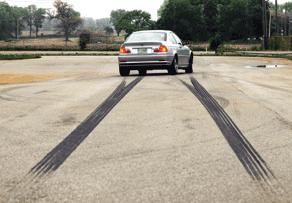As you just learned in Chapter 1, brakes do not stop the car—they simply convert energy from one form into another. The responsibility of stopping the car falls solely on the tires, or more specifically the tire-to-road interface. Only these four palm-sized patches of rubber that are in contact with the road below (the contact patches) govern how quickly a car will stop.
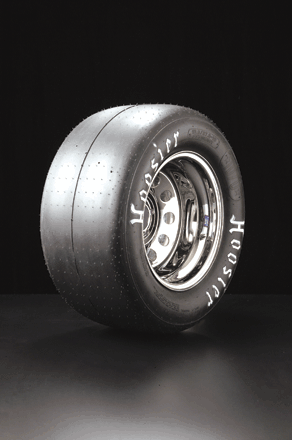
The brakes don’t stop the car—that’s the tires’ job! For this reason, tires come in a wide variety of shapes, sizes, and designs to optimize the available brake force. The lack of a tread pattern on this tire makes it a poor choice for wet-weather performance, but a great choice for racing when the track is dry. (Hoosier Racing Tire)
The First Law of Motion
You may recognize Sir Isaac Newton as the guy who allegedly defined the concept of gravity when an apple fell on his head one afternoon. However, for a few paragraphs you should look past that rather major accomplishment and focus on the first of his three stated Laws of Motion.
(Note that Newton’s First Law of Motion is not to be confused with the First Law of Thermodynamics from Chapter 1. Apparently, every physicist wants to be known for discovering the first law of something or other.)
Paraphrasing Newton with a reasonable degree of accuracy, the First Law of Motion states that an object at rest will stay at rest unless it is acted upon by an external force. Conversely, it also states that an object in motion will stay in motion unless it too is acted upon by an external force. In other words, things sitting still will just sit still until you push them and things that are moving continue to move until you do something to stop them.
Brake Forces
Applying Newton’s First Law of Motion to vehicle brake systems is relatively straightforward. It goes something like this: Once in motion, a vehicle essentially will not slow down or stop unless it is acted upon by an external force, or what can now be called a brake force.
So where do these brake forces come from? Essentially, they result from any mechanism that absorbs a vehicle’s kinetic energy (they are one and the same). Consequently, this merits a brief revisit of energy transformation factors from Chapter 1, now adding in the resulting brake force contributions for each mechanism:
- Rolling resistance brake forces result from the body and tread of the tire resisting deformation at the contact patch. As the tire flattens out against the road, a force is generated that resists the motion of the vehicle.
- Axle, differential, bearing, and engine brake forces result from rotating and reciprocating friction. As these components mesh and rub together, they resist any motion between themselves, which is then mechanically transferred to the tire-to-road interface.
- Aerodynamic brake forces result from the vehicle simply traveling through the air. As the vehicle attempts to push the air out of its path, the air molecules react by resisting the motion. In other words, the air is not happy with the situation and it pushes back (the sensation you get from holding your hand out of the car window).
- Mechanical deformation brake forces result from running the vehicle into a fixed object. Again, this is a highly undesirable, yet highly effective, way of stopping a vehicle. Turn 3 at Martinsville pushes back pretty hard, as do trees and telephone poles.
So, while it is nice to be aware of these secondary brake force mechanisms, the whole point of this book is to understand the contribution of the brake system components. Consequently, the rest of this chapter leaves these factors behind and focuses on brake forces occurring at the tire-to-road interface as a result of brake system operation.

Brake forces can come from a variety of sources other than the brake system. For example, if a mischievous co-driver were to force a car traveling at highway speeds into first gear, the resulting driveline friction forces would be transmitted immediately back to the driven wheels. Not that we speak from experience here…
Tire Slip
Tire slip, or simply slip, is the single most important concept in understanding any aspect of vehicle performance (at least in my humble opinion). Without slip, vehicles could neither accelerate, nor decelerate, nor turn, as a tire can only generate force when it is slipping. As you’ll learn in a few moments, a tire that is not slipping is free rolling, or coasting, and a free-rolling tire does not generate any force at all (except for the small amount of brake force due to its internal rolling resistance).
Before going any further, let’s clarify one important point: A tire does not need to be spinning wildly or skidding out of control to be slipping. Although these conditions are a result of a significant amount of slip, there are many other times where a slipping tire does not actually look like it’s slipping at all. Yet for all practical purposes, any time your vehicle is in motion, its tires are slipping, even though you can’t see it with the naked eye.
Applying this concept to brake system performance is relatively straightforward. In order for a tire to generate a brake force, it must be slipping relative to the road surface in the direction of travel (normally to a very small level, but it is slipping nonetheless). If a tire is not slipping, it is not generating any brake force (again, ignoring the brake force due to its internal rolling resistance).
Although that may sound odd, it makes more sense by taking a moment to formally define slip. Tire slip can be quantified mathematically by the following equation:
(1 – {speed of the tire (mph) ÷
speed of the vehicle (mph)}) x 100
What this implies is that in order for a tire to generate brake force, it must be spinning more slowly than the speed of the vehicle would suggest. However, looking at this relationship in tabular format is somewhat easier on the eyes. For this reason, make your way over the tire slip sidebar for a different look at this slightly perplexing situation.
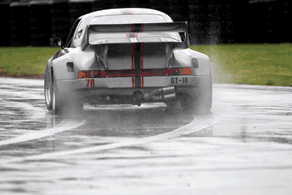
Different surface textures, environmental conditions, and slip levels can influence the brake force contribution from the adhesive, deformation, and the mechanical wear modes of friction. For example, water on the road surface partially separates the tire from the road, greatly reducing the available adhesive friction. This results in extended stopping distances. (Wayne Flynn/pdxsports.com)
Tire Slip Calculations
The data in the table below illustrates how much tire slip would be present for given combinations of tire speed and vehicle speed.
| Tire speed | Vehicle speed | Tire slip | |
| Condition 1 | 50 mph | 50 mph | 0% |
| Condition 2 | 45 mph | 50 mph | 10% |
| Condition 3 | 0 mph | 50 mph | 100% |
So, what do these numbers mean? Well, a few observations can quickly be made:
- Condition 1 indicates that when the tire speed (50 mph) is the same as the vehicle speed (50 mph), there is zero slip present. Because this is a free-rolling condition, there is no brake force present between the tire and the road. The vehicle will be coasting.
- Condition 2 indicates that when the tire slows down (45 mph) relative to the vehicle (50 mph), the slip level increases (10 percent in this case). This is the slip range where most normal braking occurs.
- Condition 3 represents a tire that has stopped spinning (0 mph) although the vehicle continues to speed along (50 mph), resulting in 100-percent slip. This is the classic ”brakes locked up” situation, which is usually accompanied by screeching sounds and billowing tire smoke. Note that this condition is also commonly referred to as sliding or skidding and is generally an undesirable way to slow down a vehicle.
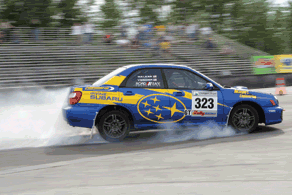
100 percent tire slip, also known as wheel lock, occurs if a vehicle is still moving yet the tire is no longer rotating. This may be amusing for the spectators, but it’s not the most effective way to achieve the best possible stopping distance. (Wayne Flynn/pdxsports.com)
How Brake Forces are Generated
So now that you know that slip is required to generate force, how exactly does the slipping tire generate brake force? As the tire rolls along without slip, there is constant interaction between the tire and the road, yet with the exception of a small amount of rolling resistance, there are no brake forces generated. However, as soon as a torque is applied to the tire by the brake system (more to come in Chapter 3), it wants to slow down.
Unfortunately for the tire, the car does not want to slow down, and consequently the tire is forced to stretch and distort. This is because there is resistance, or friction, at the tire-to-road interface that prevents the tire from decelerating as rapidly as it would like. Few things are more fun than getting a group of contact physicists together in a room and asking them why and how tires generate these forces, but for now it makes more sense to break it down into simple, bite-sized pieces.
Adhesive Effects
Any time two objects in nature come in contact with one another, there are momentary electrostatic bonds formed between them. In other words, to some extent they want to stick together. One of the best practical examples is that of garden-variety duct tape. The adhesive characteristics of the tape allow it to effectively stick temporarily wherever it is placed.
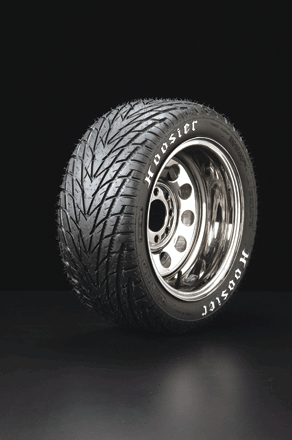
Tires used for racing in the rain are optimized to take maximum advantage of the deformation effect, since water on the track greatly reduces the adhesive effect. The rain tire shown here uses extremely soft rubber compounds to enhance deformation, while large, open channels molded into the tread face purge water from the contact patch in an attempt to increase adhesion. (Hoosier Racing Tire)
